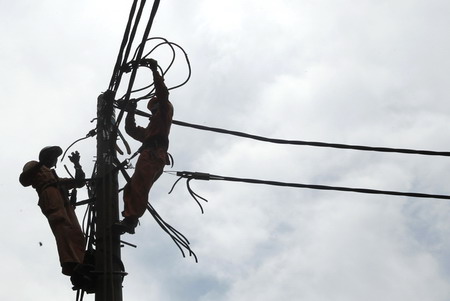A representative from PanNature suggested clearly defining the non-profit status of science and technology organizations to facilitate research, technology transfer, and application. This clarity would also enhance international collaboration and attract funding.

Vietnam pushing ahead with nuclear power expansion
Vietnam is more committed than ever to meet its growing energy needs with nuclear power while its energy-hungry neighbors have become more cautious of the energy source after the Fukushima meltdown.
Nuclear plans are set to be on the agenda as Russian President Vladimir Putin visits Vietnam Tuesday. Vietnam is working with Russian utility and energy company Rosatom on its first two-reactor nuclear power station in the south-central province of Ninh Thuan, whose construction has been delayed by three years, from 2014 to 2017.
 Workers repair an electric grid in Hanoi. Facing a chronic power shortage, Vietnam has chalked out an ambitious plan to supply at least six percent of its electricity needs from nuclear power by the year 2030. PHOTO: REUTERS
Workers repair an electric grid in Hanoi. Facing a chronic power shortage, Vietnam has chalked out an ambitious plan to supply at least six percent of its electricity needs from nuclear power by the year 2030. PHOTO: REUTERS
Last month, the US and Vietnam also inked a deal allowing American companies to develop civilian nuclear power here. Japan and South Korea have also exhibited interests in gaining a foothold in an industry that could be worth US$50 billion by 2030, according to US estimates.
Talks about funding the construction of the second nuclear power plant, also in Ninh Thuan, have been underway between Japan and Vietnam. Meanwhile, during her visit to Vietnam last September, South Korean President Park Geun-hye said her country was interested in introducing its nuclear power technology here, adding that a joint study on a project to build a nuclear power plant in Vietnam had been launched, the Wall Street Journal reported.
Facing a chronic power shortage, Vietnam has chalked out an ambitious plan to supply at least six percent of its electricity needs from nuclear power by the year 2030. With the first nuclear plant set to come on-stream in 2020, the country envisages building eight nuclear plants and 13 reactors by 2030.
“I believe nuclear power is a very reliable and economical source of energy,” said Joonhong Ahn, a nuclear professor at the University of California in Berkeley.
“I cannot think of any national energy plan without nuclear power for such a big country with a lot of potential as Vietnam,” he told Vietweek.
If things go as planned, Vietnam will be the first Southeast Asian nation to commission a working nuclear plant, though other neighbors have talked about the idea for years.
Southeast Asia has no working nuclear power plants, but more than half of the countries in the region plan to develop nuclear power as a solution to looming energy shortages. Indonesia, Singapore, Thailand, Malaysia, and the Philippines are also looking to build nuclear plants or start up non-operational ones in the next few decades.
But after Japan’s Fukushima nuclear meltdown in March 2011, the world’s worst nuclear disaster in 25 years, some officials and activists in the Southeast Asian region are asking that the pursuit of nuclear power be rethought.
“Among the ASEAN countries, it appears that Vietnam possesses the most concrete plans for developing nuclear power, including both a definite timeframe for the construction of nuclear plants and business deals concluded with Russia,” Kevin Punzalan, a researcher at De La Salle-College of St. Benilde in the Philippines who has surveyed plans for nuclear energy development across Southeast Asia, told Vietweek.
In contrast, Malaysia and Indonesia have set “target dates” for the construction of plants that have not been backed up by more detailed plans. The Philippines has the Bataan NPP, but no government has been willing to rehabilitate it for operation, especially after Fukushima.
“Vietnam will prioritize nuclear power development” to address its power crunch, Deputy Prime Minister Hoang Trung Hai said at a Vietnam-Russia business forum last month.
With countries trying to limit greenhouse gas emissions from coal and other fossil-fuel based power plants, and questions over nuclear power, energy-hungry Vietnam, with a population of 90 million, is following its own energy path.
The country generates 40 percent of its power from hydropower plants. Oil and gas reserves deliver 31 percent of energy, but crude oil output has peaked. Under a government blueprint, coal is projected to cover over 56 percent of all electricity production capacities in Vietnam by 2030, making the country an important coal importer.
But that is not a good thing.
“Coal is producing high levels of emissions and it is also polluting in other senses, whereas mining is causing destruction of landscapes, biodiversity and is causing health problems in itself,” said Koos Neefjes, the policy advisor on climate change for the United Nations Development Program (UNDP) in Vietnam.
“Coal is cheap, comparatively, even imported coal. But in all cases coal poses an enormous logistical challenge [with] huge ships, harbors required,” Neefjes said.
Although the government has enacted a green growth strategy, experts say other renewable resources — such as wind, solar and biofuels — have not been given priority.
“Vietnam has still not paid enough attention to energy efficiency,” said Trinh Le Nguyen, executive director of People and Nature Reconciliation, one of Vietnam’s few locally based conservation groups. “Nuclear, hydropower, and coal will remain the main sources of energy of Vietnam,” he said.
“Perhaps Vietnam won’t plan to invest much in renewable resources itself.”



